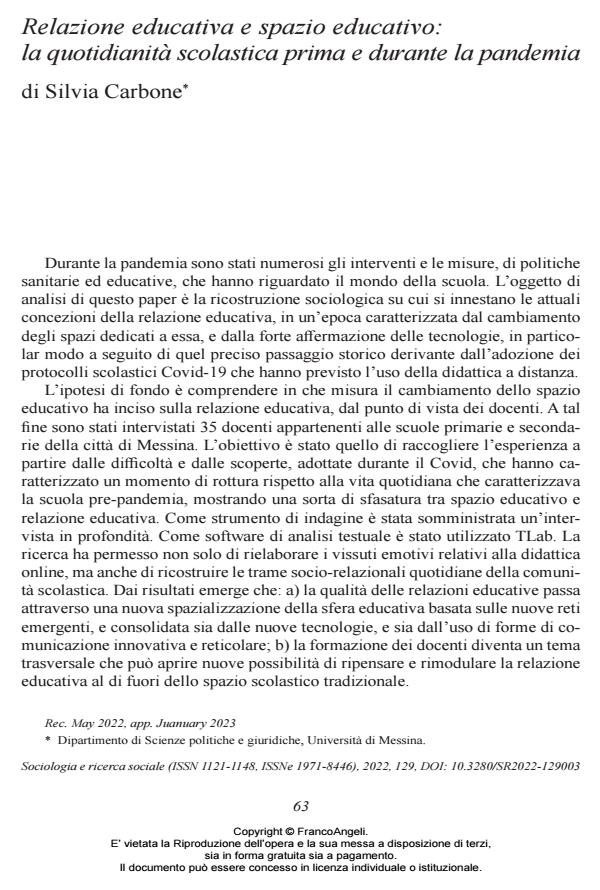Relazione educativa e spazio educativo: la quotidianità scolastica prima e durante la pandemia
Titolo Rivista SOCIOLOGIA E RICERCA SOCIALE
Autori/Curatori Silvia Carbone
Anno di pubblicazione 2023 Fascicolo 2022/129
Lingua Italiano Numero pagine 25 P. 63-87 Dimensione file 263 KB
DOI 10.3280/SR2022-129003
Il DOI è il codice a barre della proprietà intellettuale: per saperne di più
clicca qui
Qui sotto puoi vedere in anteprima la prima pagina di questo articolo.
Se questo articolo ti interessa, lo puoi acquistare (e scaricare in formato pdf) seguendo le facili indicazioni per acquistare il download credit. Acquista Download Credits per scaricare questo Articolo in formato PDF

FrancoAngeli è membro della Publishers International Linking Association, Inc (PILA)associazione indipendente e non profit per facilitare (attraverso i servizi tecnologici implementati da CrossRef.org) l’accesso degli studiosi ai contenuti digitali nelle pubblicazioni professionali e scientifiche
During the pandemic, there were many health and educational policy projects and measures developed for the school world. The subject of this paper is an analysis of the sociological reconstruction onto which the current conceptions of educational relations are grafted, in an era marked by the change in educational spaces, and the strong affirmation of technologies, especially following that precise historical period after the adoption of the Covid-19 school protocols that defined the use of distance teaching. The basic hypothesis is to understand to what extent the change of the educational space has affected the educational relationship, from the teachers’ viewpoint. To this end, 35 teachers working in the primary and secondary schools of the city of Messina were interviewed. The goal was to gather the experience from the difficulties and discoveries, adopted during the Covid, that have characterized a break from everyday life that characterized the pre-pandemic school, showing a gap between educational space and educational relationship. An in-depth interview was given as a survey tool. TLab was used as text analysis software. The research has made it possible not only to rework the emotional experiences related to online teaching, but also to reconstruct the daily socio-relational plots of the school community. The results show that: a) the quality of educational relations moves through a new spatialization of the educational sphere based on new emerging networks, and consolidated both by new technologies, and by the use of innovative and reticular forms of communication; b) teacher training becomes a cross-cutting issue that can open up new possibilities for rethinking and reshaping educational relations outside the traditional school space.
Silvia Carbone, Relazione educativa e spazio educativo: la quotidianità scolastica prima e durante la pandemia in "SOCIOLOGIA E RICERCA SOCIALE " 129/2022, pp 63-87, DOI: 10.3280/SR2022-129003